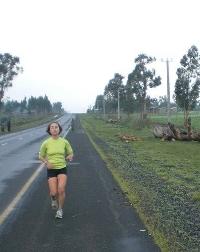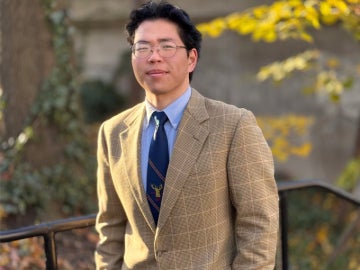Running Around the World
January 8, 2013
Liv Combe

Joanna Johnson ’11 running in Ethiopia.
Photo credit: Joanna Johnson
When a student is awarded a prestigious Watson Fellowship to spend a year traveling and working on an independent project, the Watson Foundation “tells you that the project will change from the beginning,” says Joanna Johnson ’11. “And you say, ‘No, I have this planned!’ And they’re like, ‘No, you have no idea.’”
It turns out the Watson Foundation knew what they were talking about.
Johnson, something of an Oberlin running legend and a seven-time National Collegiate Athletic Association cross country and indoor and outdoor track All-American, saw the fellowship as the perfect opportunity to combine her love of travel and competitive running. And, maybe, provide answers to an abiding question of hers: What motivates people to run?
But, as the foundation predicted, things changed. The experience ultimately altered Johnson’s plans for her future — although she had toyed with the idea of running professionally, she’s now heading down a different path.
An Interest Piqued
Johnson — who graduated with honors in biology and French and served as captain of both the cross country and track squads her senior year — began running during her sophomore year of high school in Chico, California. Before that, she was, she says, “not at all athletic.”
As she improved of the course of her time at Oberlin, Johnson often found herself training on her own or with the men’s team. The experience left her wanting more.
“I knew that there are many women out there who are equally fast and many more who are much faster than me, but due to my location I had no choice but to train alone,” recalls Johnson. “I wanted to know if other women around the world found themselves in such a situation, and I wanted to meet up with them and train with them.”
The Watson Fellowship proved to be the perfect opportunity to combine Johnson’s love of travel and her desire to continue running competitively. And, maybe, the experience could provide answers to a question that had piqued her interest while at Oberlin: What motivates people to run?
She devised a Watson program that would take her to Ethiopia, Japan, and Norway to train and live with elite runners. She quickly learned, however, that one of the more important skills to have as a Watson fellow is the ability to go with the flow. Her travel plans began to change almost as soon as Johnson began her journey, and she ultimately spent four months in Ethiopia, two in France, five in Norway, and one in Singapore.
Her itinerary brought her face to face with a variety of people and places, all of which provided Johnson with a firsthand look at the role athletics plays in cultures around the world — and why it is that people keep lacing up their running shoes and hitting the road.
Pounding the Pavement
Johnson began her journey in July 2011 with elite runners in Ethiopia as an honorary member of the Running Across Borders team. These male and female athletes spend their days running, resting, and eating — a strict regimen for people whose skill at running is the only chance they have to escape an agricultural life. Their discipline showed.
“There was no hope of me keeping up with the women at all,” says Johnson. “But they were really encouraging the whole time. I was part of the team.”
The opposite experience occurred in France.
“France has a very home-based culture,” she says. “People are less inclined to go out and meet in a running club when they could be at home with their family.” Of those (mostly men) who did make it a priority to join a running club a few times a week, few took Johnson seriously, even the coach.
“It took me winning a race to get the respect of some of the men on my team. They were all teasing me beforehand, and then after they were like, Oh! Championne!”
By the time she got to Norway, Johnson was plagued by hip injuries and unable to perform at her usual high standards. Nevertheless, she pushed through the pain with a group of immensely talented athletes — the same running club with whom Grete Waitz, the Norwegian running legend who won the New York marathon nine times, used to train.
“There can’t be anywhere else in the world where people are so athletic,” says Johnson of Norwegian sports culture. “Physical activity and being outside is really important to everyone, all year round. People are always active and the standard is a little bit higher.”
By the time she left at the end of June for Singapore, the final leg of her journey, Johnson had recovered from her injuries — just in time to become an instant celebrity of the Singapore running world during her month-long stay.
“My skill was far beyond everyone else’s’, which was strange,” says Johnson. “But I think that’s also what got me a lot of respect — people realized that maybe they could do I what I was doing, too. That was a realization for me; it became so much more than just me running. I was showing people what they could do.”
Changing Lanes
Though her project began as training with elite runners, Johnson’s focus had begun shifting.
“I came to realize early on that the world of elite running is the same everywhere,” says Johnson. Elite runners are doing the same things — intense workouts followed by rest and recovery — no mater where in the world they live and train. “If I would have done that, I’m sure it would have been beneficial to my running,” says Johnson. “But how much would I really have been learning?”
She found that her real interest lay in those everyday people who ran simply for the sake of running, not to establish a career. “What became more interesting was learning from what they thought about running, what their reasons were for running.”
Not that her Watson project ruined her career plans — rather, it kick-started them, introducing her to a model of preventative healthcare that she has yet to encounter in the United States.
“I worked with a clinic there that was more or less a physical therapy clinic,” says Johnson. “But it had not only doctors, but also personal trainers, psychologists, and nutritionists,” each specialist addressing a different aspect of a health issue with each patient.
While Johnson applies to master’s programs in public health, she’s planning the preventative health clinic she want to open one day. “It would be a combination between a clinic and a gym,” describes Johnson. “You would have running groups, yoga classes, all kinds of exercise programs, but you would also have courses about nutrition, about how to lead a healthy lifestyle — how to include more fruits, vegetables, and local foods in your diet.”
And running is still an important part of her life. Always will be. “I always want to be running, but in conjunction with something else,” says Johnson.
She plans to spend the remainder of this year in Oberlin. In January, Johnson will be running a consultation and personalized fitness program, Get on Your Feet with Jo Rabbit. For more information or to register, contact joannamjohnson88@gmail.com
And every Monday at 7 a.m. in front of Slow Train Café, you can find Johnson doing what she does best — leading a community group on a morning run.
In July 2011, fellow Watson recipient Allison Swaim ’10 also set out on her journey of riding cargo ships around the world. Read more about her travels.
You may also like…
Learning by Teaching: Oberlin Students Share Global Music with Young Learners
College and Conservatory students in PACE 103 prepare local children for an immersive community concert at Oberlin.
Nuiko Wadden ’02 Joins Oberlin Conservatory Faculty as Assistant Professor of Harp
The versatile musician brings extensive opera, orchestral, and contemporary music experience to her role
Leo Hidy ’23 Earns 2026 Marshall Scholarship
Leo Hidy ’23, a comparative American studies major who also studied business and economics while at Oberlin, has received a 2026 Marshall Scholarship that will fund two years of graduate study in the UK.


